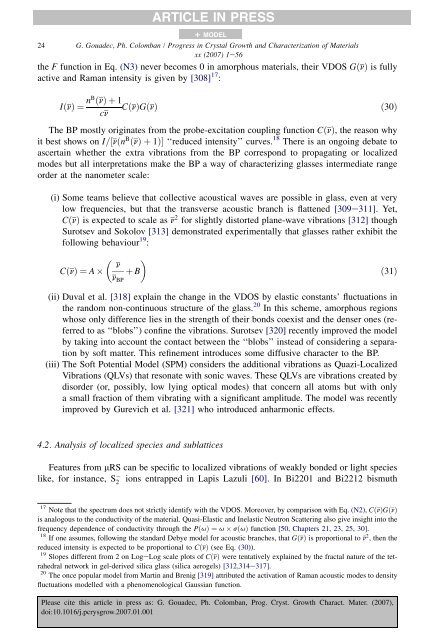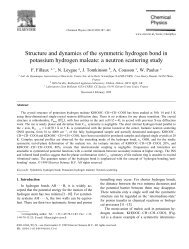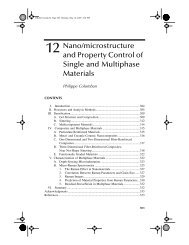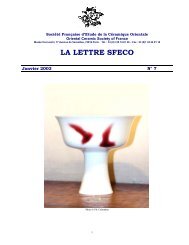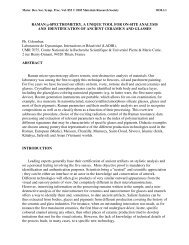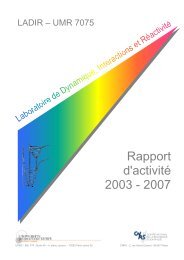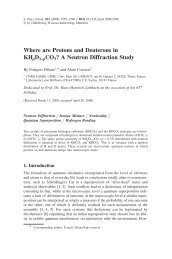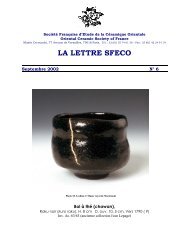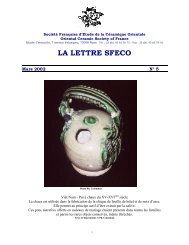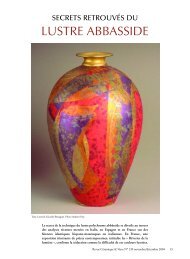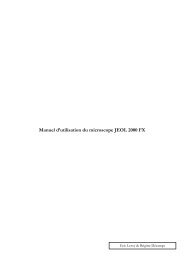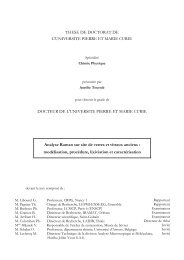Raman Spectroscopy of nanomaterials - institut de chimie et des ...
Raman Spectroscopy of nanomaterials - institut de chimie et des ...
Raman Spectroscopy of nanomaterials - institut de chimie et des ...
You also want an ePaper? Increase the reach of your titles
YUMPU automatically turns print PDFs into web optimized ePapers that Google loves.
24 G. Goua<strong>de</strong>c, Ph. Colomban / Progress in Crystal Growth and Characterization <strong>of</strong> Materialsxx (2007) 1e56the F function in Eq. (N3) never becomes 0 in amorphous materials, their VDOS GðnÞ is fullyactive and <strong>Raman</strong> intensity is given by [308] 17 :IðnÞ¼ nB ðnÞþ1CðnÞGðnÞð30ÞcnThe BP mostly originates from the probe-excitation coupling function CðnÞ, the reason whyit best shows on I=½nðn B ðnÞþ1ÞŠ ‘‘reduced intensity’’ curves. 18 There is an ongoing <strong>de</strong>bate toascertain wh<strong>et</strong>her the extra vibrations from the BP correspond to propagating or localizedmo<strong>de</strong>s but all interpr<strong>et</strong>ations make the BP a way <strong>of</strong> characterizing glasses intermediate rangeor<strong>de</strong>r at the nanom<strong>et</strong>er scale:(i) Some teams believe that collective acoustical waves are possible in glass, even at verylow frequencies, but that the transverse acoustic branch is flattened [309e311]. Y<strong>et</strong>,CðnÞ is expected to scale as n 2 for slightly distorted plane-wave vibrations [312] thoughSurotsev and Sokolov [313] <strong>de</strong>monstrated experimentally that glasses rather exhibit thefollowing behaviour 19 : nCðnÞ¼A þ Bn BPARTICLE IN PRESS+ MODEL(ii) Duval <strong>et</strong> al. [318] explain the change in the VDOS by elastic constants’ fluctuations inthe random non-continuous structure <strong>of</strong> the glass. 20 In this scheme, amorphous regionswhose only difference lies in the strength <strong>of</strong> their bonds coexist and the <strong>de</strong>nser ones (referredto as ‘‘blobs’’) confine the vibrations. Surotsev [320] recently improved the mo<strong>de</strong>lby taking into account the contact b<strong>et</strong>ween the ‘‘blobs’’ instead <strong>of</strong> consi<strong>de</strong>ring a separationby s<strong>of</strong>t matter. This refinement introduces some diffusive character to the BP.(iii) The S<strong>of</strong>t Potential Mo<strong>de</strong>l (SPM) consi<strong>de</strong>rs the additional vibrations as Quazi-LocalizedVibrations (QLVs) that resonate with sonic waves. These QLVs are vibrations created bydisor<strong>de</strong>r (or, possibly, low lying optical mo<strong>de</strong>s) that concern all atoms but with onlya small fraction <strong>of</strong> them vibrating with a significant amplitu<strong>de</strong>. The mo<strong>de</strong>l was recentlyimproved by Gurevich <strong>et</strong> al. [321] who introduced anharmonic effects.ð31Þ4.2. Analysis <strong>of</strong> localized species and sublatticesFeatures from mRS can be specific to localized vibrations <strong>of</strong> weakly bon<strong>de</strong>d or light specieslike, for instance, S 2 ions entrapped in Lapis Lazuli [60]. In Bi2201 and Bi2212 bismuth17 Note that the spectrum does not strictly i<strong>de</strong>ntify with the VDOS. Moreover, by comparison with Eq. (N2), CðnÞGðnÞis analogous to the conductivity <strong>of</strong> the material. Quasi-Elastic and Inelastic Neutron Scattering also give insight into thefrequency <strong>de</strong>pen<strong>de</strong>nce <strong>of</strong> conductivity through the PðuÞ ¼u sðuÞ function [50, Chapters 21, 23, 25, 30].18 If one assumes, following the standard Debye mo<strong>de</strong>l for acoustic branches, that GðnÞ is proportional to n 2 , then thereduced intensity is expected to be proportional to CðnÞ (see Eq. (30)).19 Slopes different from 2 on LogeLog scale plots <strong>of</strong> CðnÞ were tentatively explained by the fractal nature <strong>of</strong> the t<strong>et</strong>rahedraln<strong>et</strong>work in gel-<strong>de</strong>rived silica glass (silica aerogels) [312,314e317].20 The once popular mo<strong>de</strong>l from Martin and Brenig [319] attributed the activation <strong>of</strong> <strong>Raman</strong> acoustic mo<strong>de</strong>s to <strong>de</strong>nsityfluctuations mo<strong>de</strong>lled with a phenomenological Gaussian function.Please cite this article in press as: G. Goua<strong>de</strong>c, Ph. Colomban, Prog. Cryst. Growth Charact. Mater. (2007),doi:10.1016/j.pcrysgrow.2007.01.001


